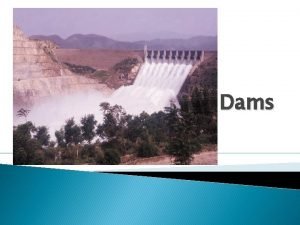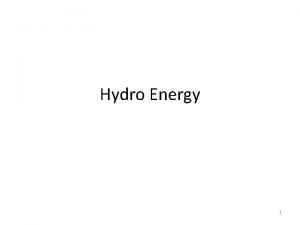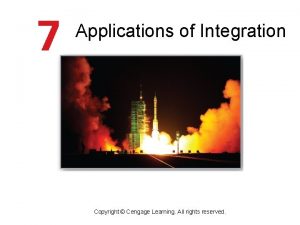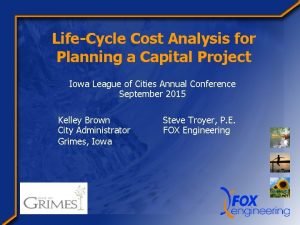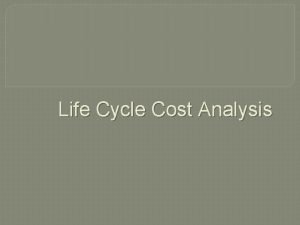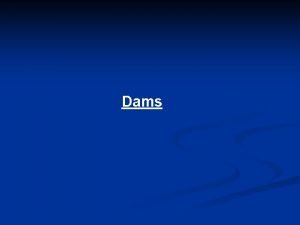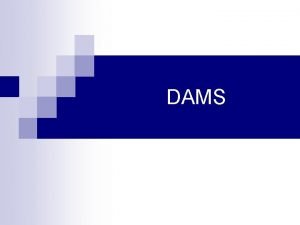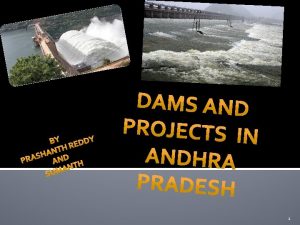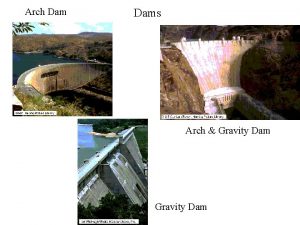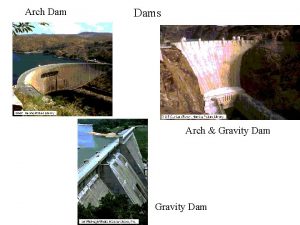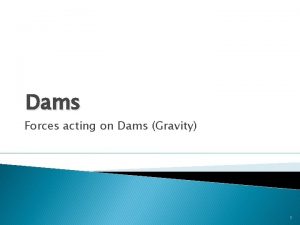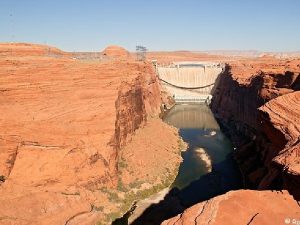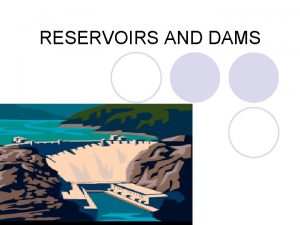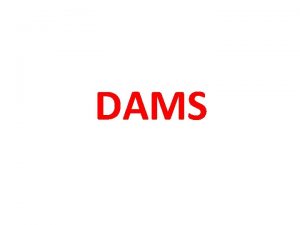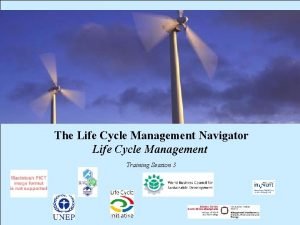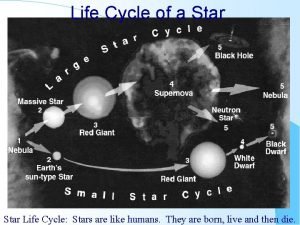The Life Cycle of Dams An Analysis of


































- Slides: 34

The Life Cycle of Dams: An Analysis of Policy Change on the Rogue River, Oregon Wendy Mc. Dermott Resource Management Graduate Student Central Washington University May 24, 2011

Case-study approach provides for lessons-learned ~~~~~~~~~~~ “Effective science and well-informed public policy are the avenues to successful management of environmental resources. ” ~ William Graf (1992) “Through documentation and analyses of case studies we can be guided by the light of science rather than curse the darkness in which we must make projections. ” ~ Bruce Babbitt (2002)

A Dammed Nation Problem ~80, 000 dams in the U. S. Disrupts natural flow regime Fragments ecosystems Block migrating fish passage Social displacement, migration and resettlement New Era of River Mgmt Convergence of a number of economic, social, and environmental factors Reflected in changing policies to re-create more natural ecosystems and to conserve natural & cultural resources Source: National Inventory of Dams, 2010

Predominant Reasons for Dam Removals in the U. S. Environmental and Social Concerns Age, Functional Status Economics & Cost-benefit Analyses Marginal Benefits from Continued Operations FERC Relicensing Process Hazard & Safety Ratings Changes in Public Opinion

Rogue River Basin ~ 13, 350 km² (5, 156 mi²) Five Subbasins: Applegate, Illinois Lower Rogue Middle Rogue Upper Rogue Over 80 dams in the Basin

Gold Ray Dam Grants Pass Medford Savage Rapids Dam Ashland

The Rogue River 346 km (~215 mi) in length Originates at Boundary Springs in Crater Lake National Park Premier salmon & steelhead fishery, whitewater rafting, and rugged scenery One of original 8 rivers named in Wild & Scenic Rivers Act of 1968

Middle Rogue Upper Rogue Lower Rogue

Rogue River Socio-Economics Agricultural Industry: 2500 directly employed 9000 indirectly $141 million in crop & livestock sales pears, wine grapes, alfalfa, corn (Climate Leadership Initiative, 2008)

Rogue River Socio-Economics Fisheries $1. 4 million commercial fishing $16 million sport fishing $1. 5 billion non-use values Recreation/Tourism $30 million in economic output 445 full- and part-time jobs (ECONorthwest, 2009)

The Dams of the Study

Savage Rapids Dam

Gold Ray Dam

Gold Ray Dam Grants Pass Medford Savage Rapids Dam Ashland

Savage Rapids Dam Built in 1921 by Grants Pass Irrigation District (GPID) 39’ high, 465’ long Combination gravity & multiple arch dam Irrigation Grants Pass Irrigation District GPID water right for 203 cfs Removed in October 2009 Photos courtesy of Josephine County Hx Society


Gold Ray Dam Built in 1904 by Ray Brothers to power Braden Mine Originally log crib style Replaced with concrete in 1941 by CA-OR Power Company 35’ high, 394’ long Hydropower Closed in 1972 by Pacific Power, deeded to Jackson County Removed Summer 2010 Photos courtesy of Jackson County


Lowry’s Theoretical Framework for Policy Changes Source: Lowry (2003)

Independent Variables POLITICAL RECEPTIVITY Interactions btwn Coalitions Reflect Political Receptivity Identify primary stakeholders What percent in favor of removal? Decision-making Venue Level of decision-making Points of Access Costs of Maintaining Status Quo Which Alternative costs more? Scientific Info on Potential Benefits Widely Embraced Broad-based scientific consensus PHYSICAL COMPLEXITY Scale – Political Jurisdictions Not # of actors, but diversity of their viewpoint Is there agreement? Dimensionality – (Decision Points along the way) Unidimensional – less layers of government Multidimensional – more layers Scope of Undertaking Size of dam, miles of river to be restored, etc.

Methods Reviewed NEPA documents & tech reports Gained initial understanding of issues at hand Six weeks in the Rogue Basin! Visited Southern Oregon Hx Society & Josephine Cnty Hx Society Collected and reviewed newspaper articles & LTEs Conducted interviews with key informants Read Public Hearing Transcripts & Public Comment from NEPA planning processes Created database, tallied for or against removal Analyzed content to identify major themes

Savage Rapids Dam

History of Savage Rapids Dam Built 1921 - lacked safe passage for fish 1929 – GPID granted water right for 230 cfs to irrigate ~18, 000 acres Never reached that amount of irrigated lands 1982 –GPID reports only 7, 738 acres under irrigation § State of Oregon reduces water right to 97 cfs § 1987 – GPID applies for additional 90 cfs 1988 – 1990 - NGOs protest water rights application § Settlement instructed GPID to study water conservation practices & investigate fish passage option including removal

Savage Rapids Dam con’t 1994 – GPID issues plan to resolve fish passage issues through dam removal Replace dam with pumping system 1995 – BOR releases Planning Report/Final EIS Preferred Alternative: Dam Removal/Pumping Facility Dam Retention Alternative No Action Alternative BUT. . Months later, new GPID Board reneges on removal, launches statewide lobbying campaign! And…Senator Brady from Grants Pass became Pres of State Senate – “Saving” dam becomes state priority!

Savage Rapids Dam For the next DECADE – Political and legal campaign rages forward Driven by “Save the Dam” contingency and Dam Removal Advocates State & Local level, U. S. Congress, Dept of Interior, and federal courts 1997 – Southern Oregon/Northern California Coast Coho Protected under the ESA as THREATENED 2001 – Settlement of federal & state litigation Required GPID to remove the dam 2006 – Funding in place, engineering & environmental analyses complete, contracts awarded, construction begins 2009 – Dam completely removed


Gold Ray Dam

Gold Ray Dam: on the fastrack 2009 – Oregon Statewide Fish Passage Priority List Gold Ray Dam = FIFTH greatest barrier to fish passage Existing fish ladder does not meet passage standards 2009 – Jackson County receives NOAA Coastal & Marine Habitat Restoration Grant American Recovery & Reinvestment Act (ARRA) Feb, 2010 – Draft EA issues Dam Removal Alternative (preferred) Dam/Fish Ladder Rehabilitation/Reconstruction Alternative No Action Alternative

Gold Ray Dam con’t May 5, 2010 – Jackson County BOC unanimous vote to remove the dam Order No. 80 -10 – directs staff to take necessary steps June 2010 – EA clearance version – for Removal May 24 to July 28, 2010 Appeal to OR Land Use Board of Appeals Appeal to Jackson County Hearings Officer Cases dismissed/denied – Order No. 80 -10 not a land use decision U. S. District Court (OR District) over due process. Appellants didn’t have a case. Removal continues, completed Oct 2010


Framework Revisited Source: Lowry (2003)

Applying the Framework Political Coalition/ Decision. Making Receptivity to Venue Change Scientific Consensus on Benefits of Change Low/ Moderate High/Moderate High Low Tolerant to Change SRD Low/ Moderate GRD High Physical Complexity Costs of Maintaining Status Quo High & Significant SRD = Savage Rapids Dam; GRD = Gold Ray Dam (jurisdictions; decision points)

Concluding Thoughts Fundamental changes have occurred but Savage Rapids much more slowly than Gold Ray WHY? Conditions were different Savage Rapids wasn’t always Fundamental; reflected Disjointed Changes for a long time Gold Ray had more pro-change variables in place Lowry’s Framework A way to categorize the process

Thank you! Questions? Courtesy of Josephine County Historical Society
 Advantages and disadvantages of dams
Advantages and disadvantages of dams Dams roma tre
Dams roma tre Rigid dam
Rigid dam Types of valleys
Types of valleys How do dams generate electricity brainpop
How do dams generate electricity brainpop Tn dams
Tn dams Forces acting on earthen dam
Forces acting on earthen dam Design of dam
Design of dam Uses of dams
Uses of dams Hydrostatic uplift on dams
Hydrostatic uplift on dams Vertical gates in dams
Vertical gates in dams Nick dams
Nick dams Roma tre dams
Roma tre dams Tasmanian dam case
Tasmanian dam case Capital project life cycle
Capital project life cycle Lcca life cycle cost analysis
Lcca life cycle cost analysis Life cycle analysis voorbeeld
Life cycle analysis voorbeeld Hát kết hợp bộ gõ cơ thể
Hát kết hợp bộ gõ cơ thể Ng-html
Ng-html Bổ thể
Bổ thể Tỉ lệ cơ thể trẻ em
Tỉ lệ cơ thể trẻ em Gấu đi như thế nào
Gấu đi như thế nào Chụp tư thế worms-breton
Chụp tư thế worms-breton Chúa sống lại
Chúa sống lại Môn thể thao bắt đầu bằng chữ đua
Môn thể thao bắt đầu bằng chữ đua Thế nào là hệ số cao nhất
Thế nào là hệ số cao nhất Các châu lục và đại dương trên thế giới
Các châu lục và đại dương trên thế giới Công thức tính thế năng
Công thức tính thế năng Trời xanh đây là của chúng ta thể thơ
Trời xanh đây là của chúng ta thể thơ Cách giải mật thư tọa độ
Cách giải mật thư tọa độ Phép trừ bù
Phép trừ bù Phản ứng thế ankan
Phản ứng thế ankan Các châu lục và đại dương trên thế giới
Các châu lục và đại dương trên thế giới Thể thơ truyền thống
Thể thơ truyền thống Quá trình desamine hóa có thể tạo ra
Quá trình desamine hóa có thể tạo ra


